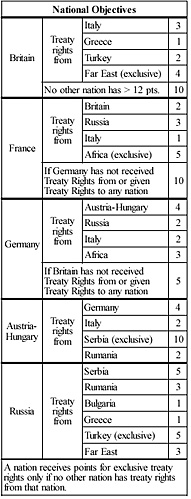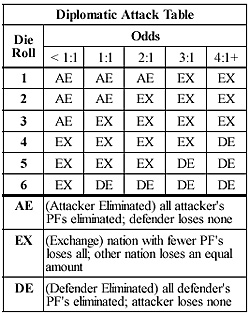 Designer: James F. Dunnigan
Designer: James F. Dunnigan
Publisher: A Gamut of Games by Sid Sackson, 1969
Number of players: Three to Five (optimum)
Equipment
1 Board This can be as simple or as elaborate as desired.
100 Poker chips (50 white; 25 red; 25 blue). If a smaller board is used, 1/2" cardboard counters may be substituted.
Cards (one each Britain; France; Germany; Russia; Austria-Hungary)
Six-sided die
1 set of rules
Setting Up
Each player chooses a nation and takes the card representing that nation, or the cards can be dealt out randomly. The players then seat themselves around the table in the following order: Britain, France, Germany, Russia and Austria-Hungary. Britain plays first, followed by the other nations in the above order.
The Play
Each player in each turn places the number of Political Factors (PF’s) to which he is entitled, as indicated on the board. (When using poker chips, a white chip represents one PF, a red chip represents five and a blue chip represents 10.) The PF’s are placed in the player’s embassies in the nations that he wishes to influence. A player is limited to placing a maximum of five PF’s in any one embassy during one turn. A player may, in order to combat the influence of another nation, place PF’s in his own embassy. Any number of PF’s can be placed in a player’s own nation during a turn.
Diplomatic Attacks
In each turn a player may make a diplomatic attack on a nation whose influence he wishes to reduce. The attack is made after placing PF’s, and a player may not make more than one attack per turn.
In order for an attack to take place, the two players involved must have PF’s in a common nation. The result of an attack is obtained from the Diplomatic Attack Table. Calculate the odds (dividing the total number of attacking PF’s by the total number of defending PF’s, rounded in favor of the defender). Throw the die to obtain the result. If, due to a diplomatic attack, PF’s are reduced below 10, treaty rights are lost until the PF’s are again built up to 10 or more.
Ending the Game
The game ends after 10 turns. The situation at this time is compared with the national objectives of each of the five nations and points are awarded to each in accordance with their fulfillment of these objectives. The player with the most points is the victor. In case of a tie the victory is shared.
Making Deals
Players are encouraged to make deals with each other and negotiations can take place at any time during the game. Any type of deal can be made except that PF’s cannot be transferred between players and players cannot combine their PF’s in a nation in determining the odds for an attack against another player with PF’s in that nation. Players may agree, however, to each attack the same opponent when it is their turn. In this way it is possible to wear down a player with a large number of PF’s in a nation and eventually cause him to lose his treaty rights.
Another type of deal is for one player to refrain from interfering with another player’s exclusive treaty rights in return for assistance in some other area. Deals are not enforceable by the rules of the game and any player is free to go back on his word any time that he feels it is to his advantage to do so.
Alliances
Two players, at any time, may form an alliance between their nations. This is a permanent agreement to work together for the duration of the game. Alliances do not change the rules of the game. PF’s cannot be transferred between allies or combined in making an attack. If one of the allies can earn points by obtaining treaty rights from the other, he must have ten or more PF’s in the embassy in order to collect the points.
At the end of the game the points of both allies are added together and if this total is equal to or greater than the combined total of the other three players, the allies have won the game. If not, the highest score among the individual players determines the winner.
It is possible during a game for two different alliances to be formed. Either alliance wins by having at least as many points as the total of the other alliance and the fifth player. In this case the individual player can win with even a low score if he succeeds in bringing about a balance of power between the two alliances.
Play by four or three players
Although Origins of World War I is definitely best when a full quota of five participate, in a pinch four can play by forming an alliance at the beginning of the game and assigning the alliance to one of the contestants who, of course, plays each nation separately.
When only three participants are available, two can be given alliances while the third player handles the remaining nation.
 Nations & PF's : Embassies
Nations & PF's : Embassies
Britain B F G R AH
France B F G R AH
Germany B F G R AH
Russia B F G R AH
Austria-Hungary B F G R AH
Italy B F G R AH
Serbia B F G R AH
Rumania B F G R AH
Bulgaria B F G R AH
Greece B F G R AH
Turkey B F G R AH
Far East B F G R AH
Africa B F G R AH
Back to Simulacrum Vol. 5 No. 1 Table of Contents
Back to Simulacrum List of Issues
Back to MagWeb Master Magazine List
© Copyright 2003 by Steambubble Graphics
This article appears in MagWeb (Magazine Web) on the Internet World Wide Web. Other articles from military history and related magazines are available at http://www.magweb.com